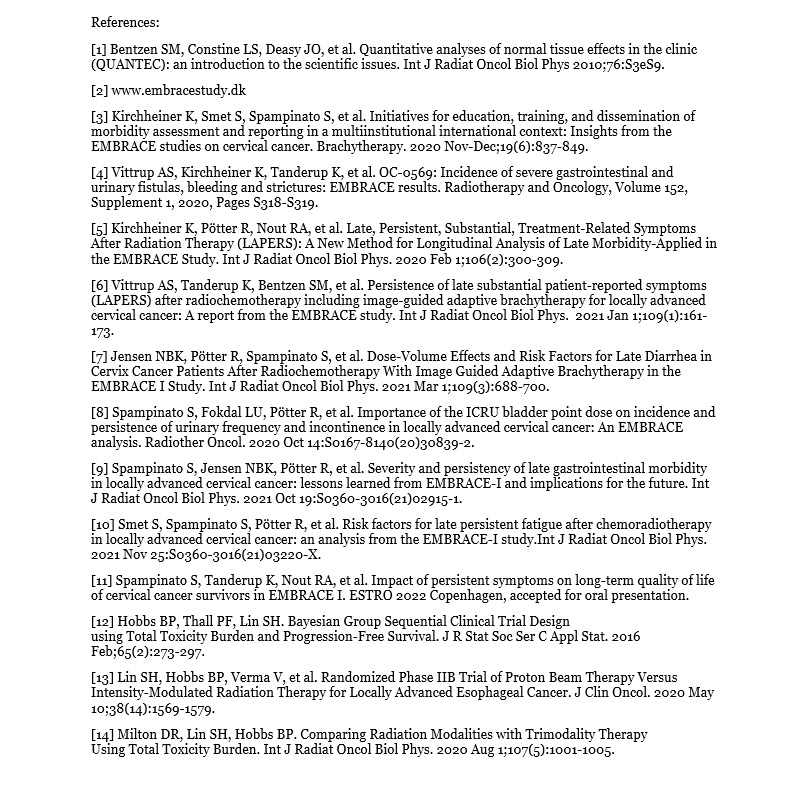Radiation oncology has a long-standing tradition of morbidity research as treatment-related symptoms are used to model dose planning aims with a trade-off in maintaining tumor control while minimizing organ at risk (OAR) damage [1]. Especially in curative treatment approaches with favorable disease outcomes and rare severe or life-threatening morbidity, patient-reported symptoms and their impact on quality of life (QoL) are in the focus of attention, as cancer survivors have to face potential impairments for a long time.
The EMBRACE I and II studies on MRI-based image-guided adaptive brachytherapy (IGABT) in locally advanced cervical cancer (LACC) have prospectively collected physician-assessed and patient-reported symptoms for over 14 years, in >2800 patients within an international multi-center framework [2]. With the longitudinal assessment of regular follow-ups, the EMBRACE studies offer a unique opportunity to explore different methods for assessing, analyzing, and reporting symptoms after radiotherapy within this large scale collection of both Common Toxicity Criteria for Adverse Events (CTCAE from NCI, National Cancer Institute) and Patient-Reported Outcomes (QoL Questionnaires from the EORTC, European Organisation for Research and Treatment of Cancer) [3].
The majority of symptoms in the EMBRACE studies are G1 and G2, which are often fluctuating over time [4]. With the aim of assessing long-term burden of symptoms, a new method has been integrated to select patients with late, persistent, substantial and treatment-related symptoms (LAPERS) [5]. It is defined if a symptom is reported above a pre-defined threshold in at least half of the late follow-ups and with progression beyond baseline. The method reflects symptom burden over time and informs patients of the risk for transient versus persistent symptoms. It provides reliable estimates to the most commonly asked question by symptomatic patients: “Will this side-effect go away or will I have to live with it?” [6] Furthermore, it has been successfully applied to establish predictive models, including volumetric, dosimetric, and clinical risk factors [7,8,9,10].
With this approach, the impact of persisting long-term symptoms on functional aspects of daily life (physical, role, emotional, cognitive, social functioning) and global health status / general QoL has been investigated. Any persisting symptom shows a significant reduction in all aspects of QoL, but the impact varied substantially between symptoms. In contrary to common expectations, treatment-related symptoms caused by damage to the organs at risk (gastro-intestinal and genito-urinary symptoms) showed less reduction in QoL aspects, compared to more unspecific symptoms, such as fatigue syndrome (weakness, exhaustion and tiredness), insomnia and pain [11].
This QoL evaluation of patients with or without single persisting long-term symptoms is an exploratory univariate approach. However, cancer survivors´ reality and narratives are much more complex: The impact of symptoms on functional aspects of daily life strongly depends on individual life circumstances, expectations and coping strategies. Moreover, the cause-effect pathways between symptoms and QoL are not always uni-directional, but occur in feedback loops; and random effects have to be taken into account, based on independent factors.
In addition, certain symptoms are highly inter-correlated and often occur in clusters. The previous findings were not able to estimate the cumulative effects of multiple occurrences of persistent symptoms in individual patients. Other study groups have developed the concept of a “total toxicity burden” score, an aggregated summary measure [12,13,14]. This method combines the impact of different symptoms in a severity-weighted sum over the course of follow-up and constitutes an interesting new approach.
In summary, PROs provide the most direct feedback reflecting the patients’ experience with disease and treatment and have been recognized as reliable endpoint within the EMBRACE studies in locally advanced cervical cancer. Complementary to the physician-assessed CTCAE morbidity, PROs have been successfully integrated into dose/volume effect relations and guided treatment recommendations regarding dose constraints. New methodologies and concepts, applied to solid prospective clinical data, will further integrate the patients´ perspective.
